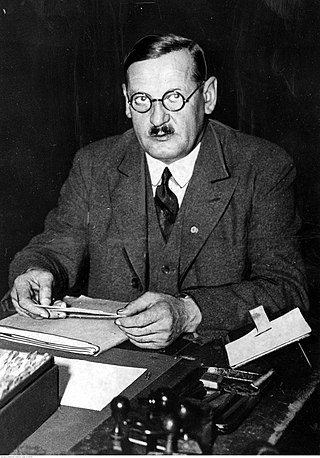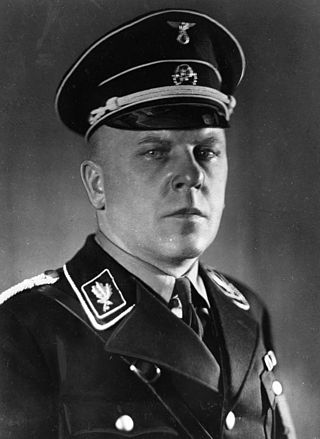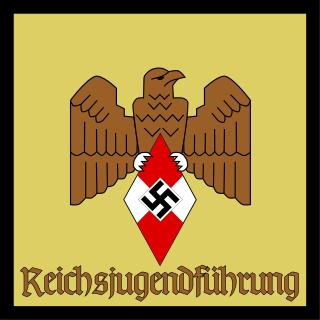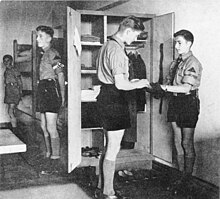
Anton Drexler was a German far-right political agitator for the Völkisch movement in the 1920s. He founded the pan-German and anti-Semitic German Workers' Party (DAP), the antecedent of the Nazi Party (NSDAP). Drexler mentored his successor in the NSDAP, Adolf Hitler, during his early years in politics.

The Nazi Party, officially the National Socialist German Workers' Party, was a far-right political party in Germany active between 1920 and 1945 that created and supported the ideology of Nazism. Its precursor, the German Workers' Party, existed from 1919 to 1920. The Nazi Party emerged from the extremist German nationalist, racist and populist Freikorps paramilitary culture, which fought against the communist uprisings in post–World War I Germany. The party was created to draw workers away from communism and into völkisch nationalism. Initially, Nazi political strategy focused on anti–big business, anti-bourgeois, and anti-capitalist rhetoric, which was later downplayed to gain the support of business leaders. By the 1930s, the party's main focus shifted to antisemitic and anti-Marxist themes. The party had little popular support until the Great Depression, where worsening living standards and vast unemployment drove Germans into political extremism.

The German Workers' Party was a short-lived far-right political party established in Weimar Germany after World War I. It only lasted from 5 January 1919 until 24 February 1920. The DAP was the precursor of the Nazi Party, which was officially known as the National Socialist German Workers' Party.

The Hitler Youth was the youth organisation of the Nazi Party in Germany. Its origins date back to 1922 and it received the name Hitler-Jugend, Bund deutscher Arbeiterjugend in July 1926. From 1936 until 1945, it was the sole official boys' youth organisation in Germany and it was partially a paramilitary organisation. It was composed of the Hitler Youth proper for male youths aged 14 to 18, and the German Youngsters in the Hitler Youth for younger boys aged 10 to 14.

The League of German Girls or the Band of German Maidens was the girls' wing of the Nazi Party youth movement, the Hitler Youth. It was the only legal female youth organization in Nazi Germany.

Karl Harrer was a German journalist and politician, one of the founding members of the Deutsche Arbeiterpartei in January 1919, the predecessor to the Nationalsozialistische Deutsche Arbeiterpartei, more commonly known as the Nazi Party.

Max Amann was a high-ranking member of the Nazi Party, a German politician, businessman and art collector, including of looted art. He was the first business manager of the Nazi Party and later became the head of Eher Verlag, the official Nazi Party publishing house. He was also the Reichsleiter for the press. After the war ended, Amann was arrested by Allied troops. Amann was deemed a Hauptschuldiger and sentenced to ten years in a labour camp. He was released in 1953. Amann died in poverty in Munich.

The Reich Security Main Office was an organization under Heinrich Himmler in his dual capacity as Chef der Deutschen Polizei and Reichsführer-SS, the head of the Nazi Party's Schutzstaffel (SS). The organization's stated duty was to fight all "enemies of the Reich" inside and outside the borders of Nazi Germany.

The National Socialist Motor Corps was a paramilitary organization of the Nazi Party (NSDAP) that officially existed from May 1931 to 1945. The group was a successor organisation to the older National Socialist Automobile Corps, which had existed since April 1930.

Reichsjugendführer was the highest paramilitary rank of the Hitler Youth. On 30 October 1931, Hitler appointed Baldur von Schirach as the Reich Youth Leader of the Nazi Party. In 1933, after the Nazi seizure of state power, all youth organizations in Germany were brought under Schirach's control and he was designated the Jugendführer des Deutschen Reiches on 17 June. When Schirach was named Gauleiter of the Reichsgau Vienna on 8 August 1940, Artur Axmann succeeded him as Reichsjugendführer. Axmann had served as Schirach's deputy since 1 May 1940.
The Encyclopedia of the Third Reich is a two-volume text edited by Christian Zentner and Friedemann Bedürftig, first published in German in 1985.
There were two main police forces of Nazi Germany under the Reichsführer-SS, Heinrich Himmler from 1936:

Adolf Hühnlein was a German soldier and Nazi Party (NSDAP) official. He was the Korpsführer of the National Socialist Motor Corps (NSKK) from 1933 until his death in 1942.

The Brown House was the name given to the Munich mansion located between the Karolinenplatz and Königsplatz, known before as the Palais Barlow, which was purchased in 1930 for the Nazis. They converted the structure into the headquarters of the National Socialist German Workers' Party. Its name comes from early Nazi Party uniforms, which were brown. Many leading Nazis, including Adolf Hitler, maintained offices there throughout the party's existence. It was destroyed by Allied bombing raids during World War II.
An Aryan paragraph was a clause in the statutes of an organisation, corporation, or real estate deed that reserved membership or right of residence solely for members of the "Aryan race" and excluded from such rights any non-Aryans, particularly those of Jewish and Slavic descent. They were an omnipresent aspect of public life in Germany and Austria from 1885 to 1945.

The National Socialist Teachers League, was established on 21 April 1929. Its original name was the Organization of National Socialist Educators. Its founder and first leader was former schoolteacher Hans Schemm, the Gauleiter of Bayreuth. The organization was based in Bayreuth at the House of German Education. On October 27, 1938, the NSLB opened its own Realschule for teacher training in Bayreuth.

The Academy for Youth Leadership was a Hitler Youth (HJ) leadership school in Braunschweig. It was the highest Nazi training facility for the training of full-time junior executives for Hitler Youth during the Nazi era. It was built between 1937 and 1939. Today, the Braunschweig College for Adult Education and the Abendgymnasium Braunschwieig are housed in this building.

SS-Junker Schools were leadership training facilities for officer candidates of the Schutzstaffel (SS). The term Junkerschulen was introduced by Nazi Germany in 1937, although the first facilities were established at Bad Tölz and Braunschweig in 1934 and 1935. Additional schools were founded at Klagenfurt and Posen-Treskau in 1943, and Prague in 1944. Unlike the Wehrmacht's "war schools", admission to the SS-Junker Schools did not require a secondary diploma. Training at these schools provided the groundwork for employment with the Sicherheitspolizei, the Sicherheitsdienst, and later for the Waffen-SS. Heinrich Himmler, head of the SS, intended for these schools to mold cadets for future service in the officer ranks of the SS.

The German Combat Games were a national multi-sport event established in 1922 by the Deutscher Reichsausschuss für Leibesübungen under Carl Diem.
The Reich Ministry for Church Affairs also sometimes referred to as the Reich Ministry for Ecclesiastical Affairs, existed in Nazi Germany from 1935 until 1945 under the leadership of Hanns Kerrl and Hermann Muhs and attempted to unify the churches and align them with the goals of National Socialism.
















